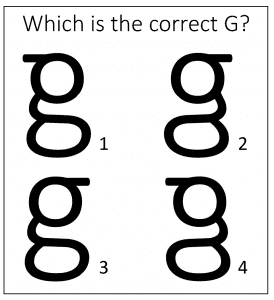This project explores the representations and computations in single-word reading and writing. Current foci of interest are
- the early stages of visual word recognition, in which a stimulus word is processed to determine the identities and positions of the individual letters
- spelling processes, in which the meaning or sound of a word is transformed into an abstract sequence of letter representations for use in writing, typing, or orally spelling the word
- the later stages of writing, in which abstract letter representations are transformed into the motoric representations that mediate writing
These topics are addressed in cognitive neuropsychological studies of adults with reading and writing deficits, studies of children with developmental spelling deficits, and studies of reading and writing in neurotypical adults.
Examples of recent or ongoing studies within this project:
- Letter Position Representations in Reading and Spelling
- What Do We Learn When We Learn to Write: Graphic Motor Plans in Writing
- Principles Governing Stroke Patterns in Writing
See also our recent study exploring the implications of skilled readers’ lack of knowledge about a very common form of the letter G.

Relevant Publications
Fischer-Baum, S., McCloskey, M., & Rapp, B. (2010). Representation of letter position in spelling: Evidence from acquired dysgraphia. Cognition, 115, 466-490.
Fischer-Baum, S., Charny, J., & McCloskey, M. (2011). Both-edges representation of letter position in reading. Psychonomic Bulletin and Review, 18, 1083-1089.
Hepner, C., McCloskey, M., & Rapp, B. (2017). Do reading and spelling share orthographic representations? Evidence from developmental dysgraphia. Cognitive Neuropsychology, 34, 119-143.
McCloskey, M., Fischer-Baum, S., & Schubert, T. (2014). Representation of letter position in single-word reading: Evidence from acquired dyslexia. Cognitive Neuropsychology, 30, 396-428.
McCloskey, M., & Rapp, B. (2017). Developmental dysgraphia: An overview and framework for research. Cognitive Neuropsychology, 34, 65-82.
McCloskey, M., Reilhac, C., & Schubert, T. (2018). A deficit in post-graphemic writing processes: Evidence for a graphomotor buffer. Cognitive Neuropsychology, 35, 430-457.
McCloskey, M., & Schubert, T. (2014). Shared versus separate processes for letter and digit identification. Cognitive Neuropsychology, 31, 437-460.
Rapp, B., & McCloskey, M. (Eds). (2018). Developmental dysgraphia. Routledge.
Schubert, T., & McCloskey, M. (2014). Pre-lexical representations and processes in reading: Evidence from acquired dyslexia. Cognitive Neuropsychology, 30, 360-395.
Schubert, T., & McCloskey, M. (2015). Recognition of oral spelling is diagnostic of the central reading processes. Cognitive Neuropsychology, 32, 80-88.
Schubert, T., Reilhac, C., & McCloskey, M. (2018). Knowledge about writing influences reading: Dynamic visual information about letter production facilitates letter identification. Cortex, 103, 302-315.
Fischer-Baum, S., & McCloskey, M. (2015). Representation of item position in immediate serial recall: Evidence from intrusion errors. Journal of Experimental Psychology: Learning, Memory, and Cognition, 41, 1426-1446.
McCloskey, M., & Rapp, B. (2017). Developmental dysgraphia: An overview and framework for research. Cognitive Neuropsychology, 34, 65-82.
Wong, K., Wadee, F., Ellenblum, G., & McCloskey, M. (2018). The devil’s in the g-tails: Deficient letter-shape knowledge and awareness despite massive visual experience. Journal of Experimental Psychology: Human Perception and Performance, 44, 1324-1335.
